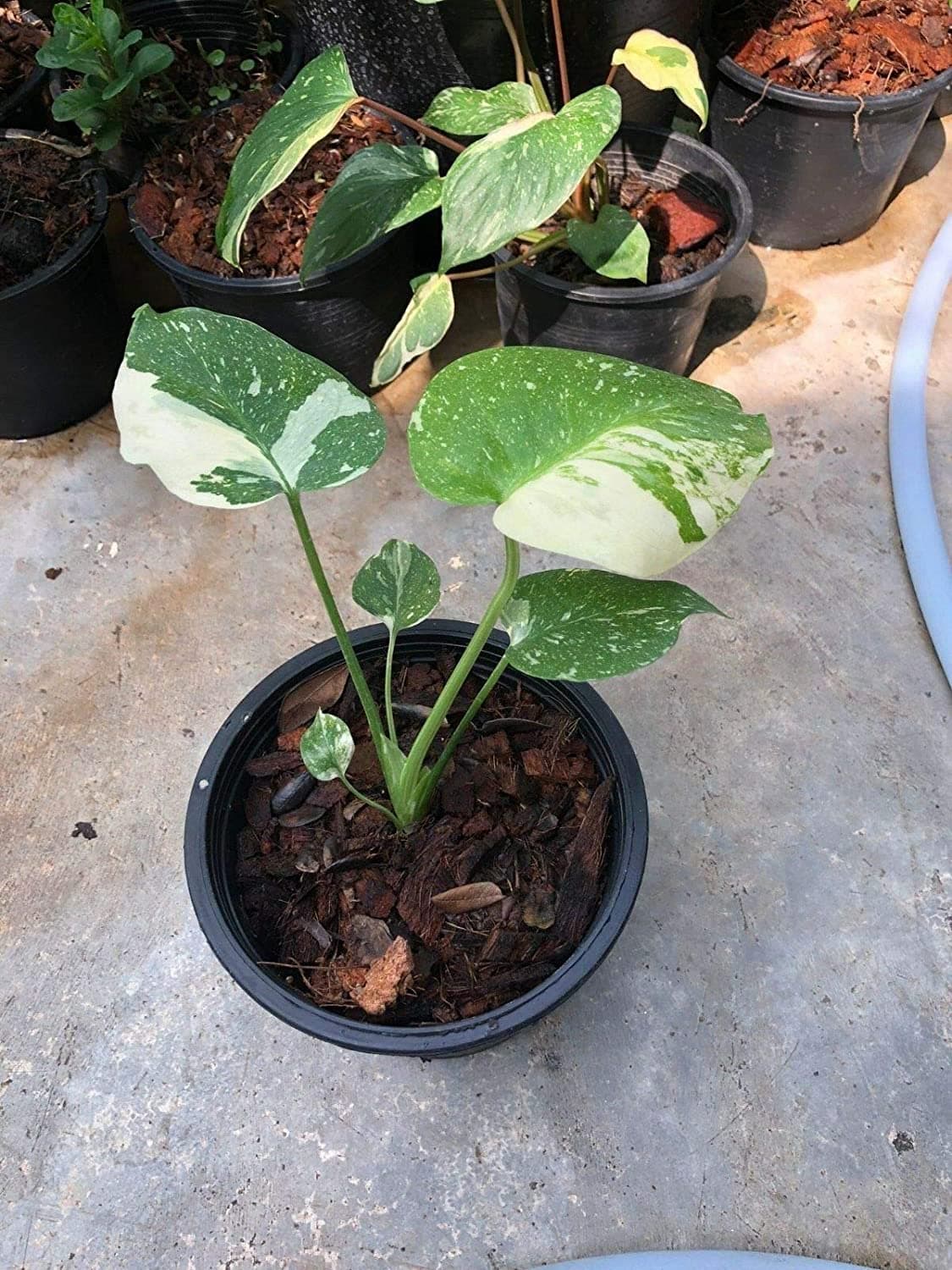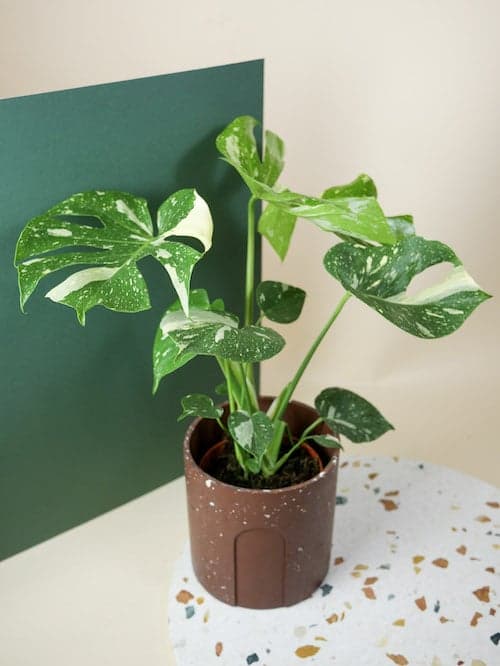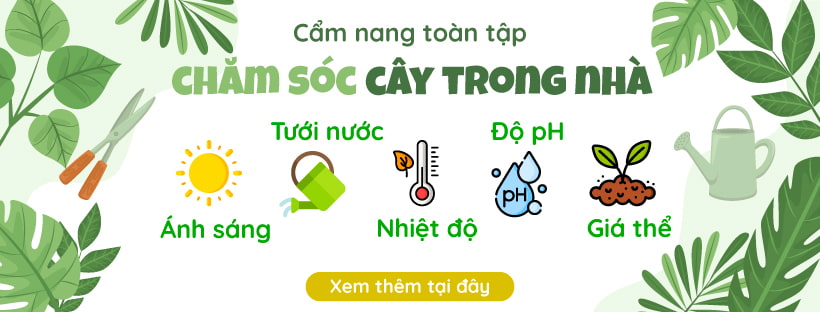Monstera Thai Constellation
| Leaf color | blue white – albo |
|---|---|
| Leaf shape | lá xẻ có lổ |
| Leaf size | vừa-lớn |
| Close | climbing |
| Roots & Tubers | aerial roots |
| Tăng trưởng | trung bình |
| Breeding | tissue culture, cutting |
| Diseases & Pests | leaf burn, fungus, spider mites, aphids, root rot |
| Varigated | đột biến màu |
Monstera Thai Constellation is a mutant Monstera plant originating from Thailand. Often referred to simply as Thai Cons, it stands out for its leaves with white spots spread across the leaves that look like a galaxy (constellation).
Note: The above information is only relative, the living conditions of the tree also depend a lot on other objective factors.
How to grow and care for Monstera Thai Constellation
Difficulty of growing Monstera Thai Constellation
Difficulty: 2-3/6
Monstera plants are great for beginners because:
✅ Adaptable to many environments.
✅ Simple care, no need for regular watering.
✅ Few pests and diseases, just avoid overwatering to avoid waterlogging.
Soil for planting Monstera Thai Constellation
Monstera plants need soil Loose, well-drained but still retains light moisture.
The ideal soil mix should have ingredients that promote healthy root growth and prevent waterlogging.
📌 Standard Monstera soil formula:
✅ 1 part light loam or loam (provide nutrition)
✅ 1 part coconut fiber or peat moss (moisturizing)
✅ 1 part carbonized rice husk or perlite (helps drain water, avoids waterlogging)
✅ 1 part rotten bark or pumice (increase ventilation)
🚫 Avoid soil that is too compacted or retains water for too long., because it is easy to cause root rot.
💡 Note:
- If you are growing Monstera in a pot, make sure with drain hole under the basin.
- Maybe organic fertilizer (worm castings, fish manure, or slow-release fertilizer) once every 1-2 months for the plant to grow strongly.
Suitable lighting for Monstera Thai Constellation
🔆 Indirect light, medium to strong (Bright, Indirect Light) is the best!
📌 Lighting details:
✅ Best: Place near a window with curtains, where there is diffused light.
✅ Can withstand: Low light, but leaves may grow slower.
✅ Avoid: Strong direct sunlight (especially midday), as it can burn the leaves, causing brown spots.
💡 Note:
- If the leaves are smaller than normal and less torn (for split-leaf Monstera), the plant may be lacking light.
- If placed in a dark room, you can use LED plant lights (grow light) for support.
📍 Ideal location in the house:
- Near the window East or West (with light curtains).
- If the window faces south, it should be further away or have a light filter.
Temperature suitable for Monstera Thai Constellation
🌿 Ideal temperature for Monstera plants: 18 - 30°C
Monstera plants prefer warm, tropical climates and cold intolerance.
If the temperature drops below 10°C, the plant may go into cold shock, stop growing or lose leaves.
📌 Notes to keep plants healthy:
✅ Avoid drafts and direct air conditioning (fans and air conditioners can dry the leaves).
✅ Do not leave plants outdoors in cold weather. if the temperature falls below 15°C.
✅ If it is too hot (>30°C), Increase watering, create humidity by misting or placing the pot near the water tray.
📍 Signs of plants affected by temperature:
🚫 Too cold: Leaves turn yellow or droop.
🚫 Overheat: Leaves have brown spots and wilt quickly even when the soil is still moist.
Water give Monstera Thai Constellation
Monstera plants like moist but not soggy soil. The ideal watering method is Water again when the top layer of soil (about 2-3cm) is dry..
📌 Watering principles:
✅ Deep irrigation until water flows out of the bottom of the pot, helping the roots absorb enough water.
✅ Check soil moisture before watering by pricking your finger or using a test strip.
✅ Reduce watering in winter, water only when the soil is completely dry.
🚫 Avoid over watering, because it can easily cause waterlogging and root rot. If you see pale yellow leaves, you may be overwatering!
📍 How many times a week to water?
- Hot season: 1-2 times/week
- Winter: 7-10 days/time
- If grown in water (hydroponics): Change water 1-2 times/week to avoid cloudy water.
Humidity give Monstera Thai Constellation
Monstera plants originate from tropical rainforests, so they prefer high humidity environments.
However, the plant can still tolerate humidity of about 40 - 50%, but if too low, the leaves may dry out at the edges and curl.
📌 How to maintain proper humidity:
✅ Light mist in the morning (but don't get the leaves too wet to avoid fungus).
✅ Place the pot on a tray of pebbles with water. to increase ambient humidity.
✅ Use a humidifier, especially when using air conditioning or living in dry places.
✅ Group planting to create a naturally humid environment.
Ideal pH give Monstera Thai Constellation
Monstera plants grow best in soil with a slightly acidic to neutral pH, about 5.5 - 7.0.
🌿 If the soil pH is too low (below 5.5), plants may have difficulty absorbing nutrients, especially calcium and magnesium.
🌱 If the pH is too high (above 7.0), the plant may lack micronutrients such as iron, leading to yellow leaves.
Pet-friendly
Monstera plants are not pet-friendly because the leaves and stems can cause mouth irritation, vomiting, drooling or difficulty swallowing if chewed by dogs or cats. If you plant the plant, you need to take careful measures to protect it. 🚧🐕🐈
💡 Additional notes:
💡The plant may “cry” (water comes out at the edges of the leaves) if the humidity is high or the soil is too wet, it is not a disease!
💡Monstera tends to grow towards the light, so you should Rotate pot every 1-2 weeks for balanced plant growth.
💡If you see unusual brown spots or white aphids on the leaves, you can wipe the leaves with mild soap solution or neem oil.
💡If you want to propagate the plant, simply cut a section of stem with aerial roots Then plant in water or soil, the plant will grow new roots after a few weeks.
💡If the plant grows too densely, you can cut off old leaves or weak branches to concentrate nutrients on new leaves.
💡Monstera is a climbing plant, so if you want the plant to have larger leaves and more branches, coconut fiber stakes or moss poles to take root
Indoor Plant Care Guide
The most important and basic knowledge about growing plants indoors:









